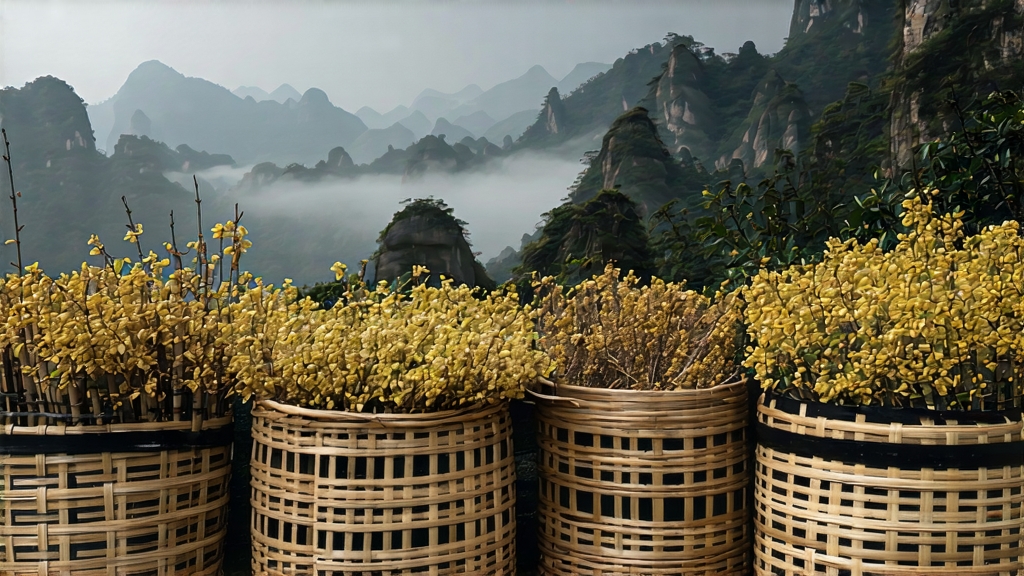
Hidden in the cloud-wrapped Dabie Mountains of western Anhui Province, Huoshan Huangya has quietly captivated Chinese emperors, poets, and tea sages for more than seven centuries. Unlike the better-known green, black, or oolong teas, this “yellow bud” tea belongs to the smallest and most enigmatic of China’s six great tea families—yellow tea—whose very existence is owed to a single, maddeningly delicate extra step called menhuang, “sealing yellow.” When executed with the precision of a watchmaker, menhuang transforms already-exquisite early-spring buds into liquor the color of topaz and a fragrance that connoisseurs liken to fresh orchids, toasted pumpkin seeds, and mountain mist in one breath. To international drinkers who equate Chinese tea with dragon-well greens or pu-er bricks, Huoshan Huangya offers a rare passport into an almost forgotten realm of imperial taste.
History: from mountain herb to tribute treasure
The first written record appears in 1495, during the Ming dynasty, when the local gazetteer of Huoshan County lists “yellow buds” among goods sent to the capital as tax-in-kind. By the Qing Qianlong era (1736–1795) the tea had become so coveted that the emperor decreed the entire annual production of the three highest gardens—Jinji Mountain, Golden Valley, and Buddha’s Palm Ridge—reserved for the palace. Legend claims that when Qianlong toured the south he refused all other beverages while writing poetry, insisting only on Huoshan Huangya steeped in mountain snow. After the fall of the empire the gardens fell into neglect; the craft survived only because a handful of monks continued to fire tiny batches for temple offerings. When Chinese tea scholars “rediscovered” the cultivar in 1972 they found just three elderly artisans who still remembered the full menhuang protocol. Today the tea is protected under China’s Geographic Indication scheme, and the county limits harvest to barely 30,000 kg a year—less than one day’s output of a single large Fujian oolong factory.
Terroir: why the mountain makes the bud
Huoshan County lies at 31° N, 800–1,200 m above sea level, where the Dabie range funnels warm, moist air from the Yangtze valley into sudden nightly fogs. The temperature swing can exceed 15 °C between noon and dawn; the stress forces the tea bush (a local small-leaf Camellia sinensis var. sinensis clone known as “Huoshan early bud”) to pack amino acids into every nascent tip. Soils are yellow-brown laterite rich in iron and quartz, providing the slight astringency that later balances the tea’s natural sweetness. The most coveted plucking window opens around Qingming festival (4 April) when only the unopened bud or the bud plus half-open first leaf meet the “sparrow’s tongue” standard—less than 2.5 cm in length and still downy silver-white.
Craft: the art of controlled suffocation
After dawn plucking, the buds are carried in bamboo baskets lined with fresh fern leaves to the village workshop. The first step looks like green-tea fixation: wok-roasting at 160 °C for three minutes to kill the leaf enzymes. Yet here the master already modulates the heat so that only 70 % of green character is removed, leaving enough moisture and enzymatic activity for the critical next phase—menhuang. The hot leaves are piled 5 cm deep inside oak boxes, covered with wet linen, and left in a 30 °C, 75 % humidity chamber for 40–70 minutes. During this “yellowing” the chlorophyll slowly oxidizes, tannins polymerize, and a unique aroma compound (3-hexenyl formate) forms, giving the tea its hallmark orchid-pumpkin note. One minute too long and the liquor becomes flat; one minute too short and the greenness stays, forfeiting the “yellow” designation. The master judges readiness by smell alone: when the leaf emits a scent reminiscent of fresh corn milk, the pile is spread out again for low-temperature charcoal firing (70 °C) repeated three times until moisture drops to 5 %. The entire process spans three days and demands that the worker never sleep more than two consecutive hours—reason enough why so few producers remain.
Grades and cultivars
The State Standard GB/T 19698-2008 recognizes four grades of Huoshan Huangya, all based on bud